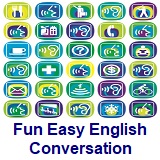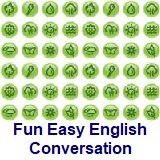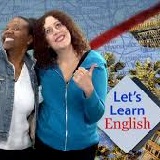|
|
| |
|
|
| |
|
|
|
|
| |
 Lesson
4 - Informal Introductions Lesson
4 - Informal Introductions
Dialogs for everyday use. Short situational dialogs for
students of English as a Foreign (EFL) or Second (ESL)
Language. |
|
|
|
Informal Introductions
Jim: Who’s the tall girl next to Barbara?
Charles: That’s Mary Anderson.
Didn’t you meet her at
Steve’s party?
Jim: No, I wasn’t at Steve’s party.
Charles: Oh! Then let me
introduce you to her now. Mary, this is my cousin Jim.
Mary: Hi, Jim. I’m glad
to meet you.
Jim: I’m glad to meet you. Can’t we sit down somewhere and talk?
Mary: Sure, let’s sit over there. |
|
|
Conversation Notes |
- Who’s
- The contracted form of who is. It should not be confused
with the possessive whose, which, although pronounced the same (/huwz/), has a different
meaning.
- Didn’t you meet her
- Note the use of the negative question. While generally
used to indicate the expectation of an affirmative answer, here it expresses
surprise that the answer to the question will probably—and unexpectedly—be
negative.
- Note that in this sentence, the strongest stress, and
the high point of the intonation, falls on at—although prepositions normally
receive weak stress. It is as if at, in this case, were equivalent to
present or there, as in I wasn’t present or I wasn’t there—in which the
adjective and adverb, respectively, would normally receive the strongest
sentence stress.
- Mary, this is my cousin Jim
- Notice that the introducer mentions the girl’s name
first, and introduces the young man to her (not vice versa). This is the
normal, courteous manner of introduction among speakers of American English.
- Notice the rising intonation on Mary, a name used in
direct address. See note in Dialog 3.
- Hi
- See note in Dialog 2.
- I’m glad to meet you
- Note that the second speaker says this sentence with a
different intonation than the first speaker used. The second speaker
emphasizes you. (Compare Lesson 1. How are you?) Can’t we sit down…? = Would
you like to sit down…?
- Sure
- Often used in informal conversation as a strong
affirmative response equivalent to yes, certainly, of course, etc.
|
|
Source: U.S. State Department |
|
|
Additional
Conversation Lessons |
 Conversation Conversation
This is a collection of 36 situational conversations
which focus on spoken American English in a relatively
natural way....these
lessons are for intermediate students. |
 Conversation Conversation
This is a collection of 30 situational conversations. Each conversation is
accompanied by language notes....these
lessons are for advanced students. |
 Conversation Conversation
English conversation lessons. 52
lessons covering pronunciation, speaking,
writing, and grammar topics....these
lessons are for beginning students. |
 Conversation Conversation
English conversation lessons. 30
lessons focusing mostly on communication and
grammar topics....these
lessons are for intermediate students. |
|
|
|
|
|
|
|
|
Conversation Information |
Are You How You Talk?
(Beginner - Listening,
reading)
A video lesson to
help with your understanding of American dialects.
The English is
spoken at 75% of normal speed.
Click here to visit the lesson page. |
Are You How You Talk?
(Beginner - Listening)
An audio lesson to
help with your understanding of American dialects. The English is
spoken at 75% of normal speed.
Click here to visit the lesson page with the written script for this
audio program. |
Improve Your Pronunciation by Training Your
Ears
(Beginner - Listening)
An audio lesson to
help with your
pronunciation and English language
reductions. The English is
spoken at 75% of normal speed. Great English pronunciation tips.
Click here to visit the lesson page with the written script for this
audio program. |
|
|
|
|
More Conversation Information |
Disagreements in Everyday Conversation - Part 1
(Beginner - Listening)
An audio lesson to
help with your understanding of American
conversation. The English is
spoken at 75% of normal speed.
Click here to visit the lesson page with the written script for this
audio program. |
Disagreements in Everyday Conversation - Part 2
(Beginner - Listening)
An audio lesson to
help with your understanding of American
conversation. The English is
spoken at 75% of normal speed.
Click here to visit the lesson page with the written script for this
audio program. |
Giving and Receiving Compliments
(Beginner - Listening)
An audio lesson to
help with your understanding of American
conversation. The English is
spoken at 75% of normal speed.
Click here to visit the lesson page with the written script for this
audio program. |
How to Make a Complaint in English
(Beginner - Listening)
An audio lesson to
help with your understanding of American
conversation. The English is
spoken at 75% of normal speed.
Click here to visit the lesson page with the written script for this
audio program. |
|
|
|
|
Search Fun Easy English |
|
|
|
|
|
|
|
|
|
|
|
|
|
|
|
About
Contact
Copyright
Resources
Site Map |